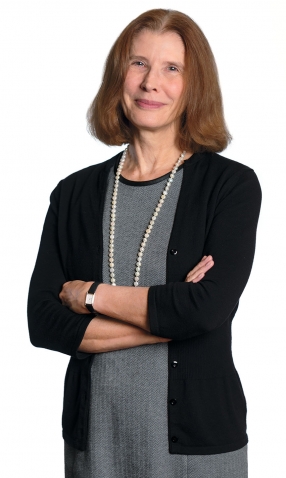Photo by Lisa Abitbol
Professor of Art Rebecca Bedell ’80 works inside an icon of midcentury modernism, the Jewett Arts Center. Her office walls are hung with contemporary paintings by colleagues, among them associate professors of art Daniela Rivera and David Teng Olsen, and emerita professor Bunny Harvey. But her interests often incline to earlier eras.
Bedell’s most recent book is Moved to Tears: Rethinking the Art of the Sentimental in the United States (Princeton). In it, she aims to uproot what she terms “the still tenacious modernist prejudice against sentimental art.”
In the 18th and 19th centuries, she says, the sentimental was highly valued. “It meant art that had an ability to touch you, to transform your feelings and make you feel more connected to others—art that had a socially transformative role. And then that shifts with the advent of modernism, [which] redefines ‘sentimental’ art as something feminine and commercial and domestic.”
Modernist criticism of the sentimental began in the mid-19th century in France, and took a while to reach the U.S. But the attitude “is still with us,” Bedell says. “‘Sentimental’ is still one of the most negative, derogatory terms that critics fling at works of art.”
In her book, she seeks to define and complicate “ideas about what sentimental art looks like, who made it, and the cultural work it does.”
Among the artists Bedell examines in Moved to Tears are Charles Willson Peale in the late 18th century; George Inness (whose 1877 landscape, A Gray Lowery Day, is one of her favorite paintings in the College’s Davis Museum), Winslow Homer, Mary Cassatt, and John Singer Sargent in the 19th; and Frank Lloyd Wright in the early 20th century.
In a chapter on “Sentimental Landscapes,” Bedell considers Mount Auburn Cemetery in Cambridge, Mass. It was “part of the socially transformative ambitions of the sentimental in the 19th century to create cemeteries that weren’t terrifying places, that would be soothing and comforting, both to people who were contemplating their own death, and people who had lost loved ones—to create a landscape that was meant in this sentimental way to wrap its arms around you and comfort you,” she says.
Bedell sees a similar effect in the College’s landscape. “There’s that sense of embracing a comforting nature and connecting to the natural world, which carries through into current environmental art. It’s about our connectedness to the natural world, the harm we’ve done to the natural world, our need to care for the natural world—all sentimental feelings in the way I understand the term.”
Much of Bedell’s earlier work centered on the intersection of art and science. Her 2001 book, The Anatomy of Nature: Geology and American Landscape Painting, 1825–1875 (Princeton), explored the impact of new scientific findings on the Hudson River School artists.
Her interest in science goes back to Wellesley. “The classes that had the most important effect on the way I understand the world were my two classes in what was then called ecology, and would now be environmental science,” she recalls. “I started out a biology major, and then I took art history, which I had never been exposed to in my little high school in southern Illinois. It was different than now in that it was very Western-focused. But I learned to ask questions of works of art that can be applied not just to the Western canon but to any work of art. My ambition as a teacher is to provide [students] with tools for looking and thinking about works of art that they can carry anywhere.”
Bedell worries that today’s students are turning away from her discipline. “There is a broad societal suspicion of the humanities in general,” she says. “There’s a question about, ‘What’s the value of art history? Is it just an elitist and exclusionary course of study?’ I hope that we can move past that and draw people in to work with some of the most wonderful, beautiful, moving, and transformative things that have ever been made by human beings on the planet.”
One might call her sentimental. And that’s a good thing.








We ask that those who engage in Wellesley magazine's online community act with honesty, integrity, and respect. (Remember the honor code, alums?) We reserve the right to remove comments by impersonators or comments that are not civil and relevant to the subject at hand. By posting here, you are permitting Wellesley magazine to edit and republish your comment in all media. Please remember that all posts are public.